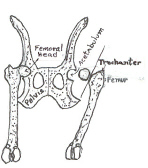Dogs for sale
Pet Supplies
How to draw a dog
Join Our Dog Forum FREE!
Trendy Dog Clothes
Dog Supplies
Dog Forum
Dog Health
Dog Articles
Dog Posters
2010 Dog Calendars
Dog Cages
Portable Dog Crates
Electronic Dog Doors
Dog Kennels
Small Dog Clothes
Slow Cooker Recipes
Dog Leads
Pet Travel Guide
Toy Dogs Guide
Dog Supplements
Dog Medicine info
Dog Allergies
Dog Portraits
Dog Resources
Sitemap

Hip Surgery In Dogs and Cats
Ron Hines DVM PhD 10/6/03
The hips of dogs and cats are composed of two bones, the pelvis with its socket, the acetabulum, and the large leg bone or femur with it’s round head, which fits snuggly into the acetabulum. Stout ligaments hold this joint together and allow it to rotate smoothly.
The hips of dogs and cats are subject to more problems that any other joint of the body. Some of these problems result from accidents.
Others result from the wear and tear, disease and time. Regardless of cause, many of these problems can be lessened and the pets rendered pain-free through the construction of an artificial cartilaginous (cartilage) joint. This surgery is called femoral head arthroplasty, ostectomy or femoral head excision. Over my career, the majority of these cases have been in pets that had their natural joint destroyed by automobile accidents.
In these cases, failure to re-align the joint promptly resulted in a “trick” or painful joint. Other reasons for performing this surgery include a chronically luxating (separated or loose) joint due to hip dysplasia, arthritis of the hip, aseptic femoral head necrosis (Legg Perthe’s Disease or “dissolving femoral head”), and accidental fractures of the femoral head and neck. The head of the femur receives all of its blood and nutrients through the femoral neck so femoral neck fractures repaired with screws and pins only succeed in about half the cases. In the other half, arthritis and a painful hip result. In these unsuccessful cases, femoral head excision usually allows the pet to regain excellent use of the leg.

Every veterinarian’s technique differs. Antibiotic administration and sterility are extremely important when I do joint and bone surgery. In performing this surgery, I incise and peal back the skin of the hip for good visualization of the muscles, ligaments and bone that form the joint. In preparation for the procedure, I locate and mark a large nerve (the sciatic nerve) that runs just posterior to the joint so that I do not injure it. I remove the diseased femoral head with a plier-like tool called rongeurs and file the bone smooth. I relocate surrounding muscle and cartilage as padding between the ends of the bone and then I place several harnesses of stainless steel drilled through the hump (protuberance) on the femur called the greater trochanter. Using suture material and nylon cord that lasts for the rest of the pet’s life, I construct a synthetic joint.
It is amazing how well the body adapts to this surgery. The biggest problem is that results do not tend to be as good when a dog weighs over forty pounds or a dog or cat is elderly. Joint pain is due to the grinding together of the two bones of the hip. In a femoral head excision, the portion of the femur that grinds against the pelvis is removed and soft tissue is placed between the two bones as a cushion.
With time, cartilage spans the joint and allows almost natural motion. After surgery, the animal maintains its knee slightly straighter to compensate for the slight shortening of the femur. For the first 4 weeks after surgery I confine the pet to a small cage and have the owner frequently massage the muscles of the leg. By the fifths or sixth week after surgery I encourage as much light activity as possible to prevent further atrophy (withering) of the muscles of the leg.
I have the owners passively flex and extend the leg and continue massages four times a day. Dogs and cats do quite well on three legs so it is difficult to start them using the repaired leg. Sometimes I resort to taping a sock onto their good rear leg to encourage them to use the newly reconstructed joint. I have also found that swimming really hastens recovery and use of the affected leg. Within six months of surgery almost all dogs lope about as if nothing had happened. I love to do this surgery because it is one of the most successful, heartening and emotionally rewarding procedures I perform.